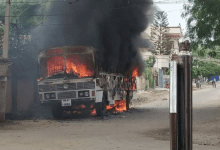There are six lakh villages in India and majority of the population still lived in rural areas. What Modi government has done in the last four years is to provide electricity to nearly 19,000 villages, which still did not have power. Electricity was provided to other 5.8 lakh villages by the previous governments and of course the pace could have been better. Modi, however, took this task on a mission mode and completed ahead of the schedule. A report, for Different Truths.
It is really sad that India had taken 70 years after Independence to provide electricity to all its villages. It is not that the previous governments had not done anything and that Prime Minister Narendra Modi had come with a magic wand to accomplish this great task. There are six lakh villages in India and majority of the population still lived in rural areas. What Modi government has done in the last four years is to provide electricity to nearly 19,000 villages, which still did not have power. Electricity was provided to other 5.8 lakh villages by the previous governments and of course the pace could have been better. Modi, however, took this task on a mission mode and completed ahead of the schedule
It is a big achievement and even the remotest villages in difficult terrain in Jammu and Kashmir, Himachal Pradesh, and North-eastern states, particularly Arunachal Pradesh, have been electrified in the past four years. One of the factors that are responsible for rural electrification not making the desired progress is poor administrative capabilities of some of the backward states. Modi had ensured even states like Bihar, Uttar Pradesh, and Madhya Pradesh have achieved electrification of all the villages. States like Kerala and Tamil Nadu had achieved 100 percent electrification some decades ago. Other southern states, Gujarat and Maharashtra have not lagged far behind.
Even though these states, most of them advanced, have achieved this task, there are still some villages where many homes in poor hamlets are yet to be electrified as they do not have enough money to pay initial charges to get the power connection. If Modi completes this task of providing electricity to all homes in all the villages as promised by this year-end, it will be a great achievement. At present, a village is considered electrified if 10 percent of its homes and all public buildings are connected to the grid.
World Bank figures show 200 million people in India still lack access to electricity. India is the world’s third-largest producer and consumer of power. But poor distribution, due to line losses and theft, is perhaps the biggest challenge. Modi government promises to electrify all household in all the 5.97 lakh villages by December 2018. This is certainly a tough ask. According to official estimates, about 3.14 crore of rural households, that is 17 percent of 17.99 crore rural households, still do not have any access to electricity. The highest number is in Bihar, Uttar Pradesh, Assam, Jharkhand, and Odisha. To take electricity to all households by end of 2018, the government has launched the Pradhan Mantri Sahaj Bijli Har Ghar Yojana or the Saubhagya scheme. Of the Rs 16,320 crore needed for the task, Rs 12,320 crore has already been provided in the Union Budget.
But what is more important and difficult for the Modi government is to ensure all households, industry and commercial complexes get uninterrupted power supply round the clock and all through the year. All power generation put together, India has not crossed 300 gw. China’s power generation is three times more at over 900 GW. India will have to at least double its power generation capacity to 600 GW in the next five years if it has to meet its growing demand.
India’s banking industry is in doldrums because of the massive sub-prime lending to infrastructure, particularly the power sector since 2011. Many of the state electricity boards are sick because of supply of highly subsidised, if not free, power. Despite the huge subsidy, power tariff in India for commercial and industrial purposes is one of the highest in the world, making manufacturing virtually unviable. This is one of the reasons for India being a high-cost economy with corruption and bureaucratic hurdles being the others.
Of course, providing electricity connection is the first step but till India achieved uninterrupted power supply, one cannot claim to have provided electricity to all. For that drastic power sector reforms are needed, including levying proper user charges to all and minimizing power theft and line losses to ensure that state electricity boards and the power distribution companies do not run into losses year after year putting a heavy burden on the state exchequer.
Some beginning has been made by way of UDAY scheme. Because of an unsteady power supply, many manufacturers depend on diesel generating sets making power that much more expensive. India depended largely on imports, nearly 80 percent, for its crude oil requirement whose prices are ever rising. This not only puts a strain on country’s balance of payments position but makes the cost of production high resulting in Indian manufactured products becoming uncompetitive.
India has huge potential for development of renewable energy, be it hydel, wind or solar. Besides, India has one of the largest coal reserves for thermal power generation. All these can be exploited if only India puts the entire power sector in order through massive reforms and expansion of distribution network. One only hopes the Modi government has the necessary political will to embark upon this big-ticket reforms so that the fruits of his mission to provide electricity to all villages and households serve its purpose and bring about a sea-change in social development.
K R Sudhaman
©IPA Service
Photo from the Internet





 By
By

